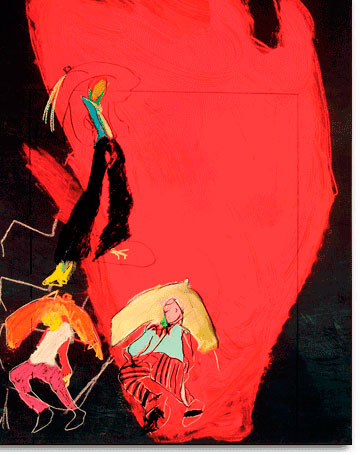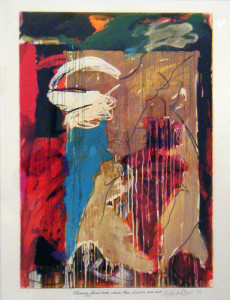Mary Lovelace O’Neal in ‘Interventions in Printmaking: Three Generations of African American Women’, Allentown Art Museum, until April 12, 2015
About:
 See, so heaven can hear you, 2007.
See, so heaven can hear you, 2007.
Mary Lovelace O’Neal utilizes high abstraction to give voice to her ephemeral artistic expressions of “intangible elements of the human spirit.” Influenced by Abstract Expressionism and Minimalism, she has created highly abstracted compositions in which figurative elements are beyond or almost beyond recognition. Dreamlike shapes exist on the picture plane of her creations and almost come to life with vibrant coloration and wet-looking surface qualities. In her 1993 lithograph Racism is Like Rain, Either It’s Raining or It’s Gathering Somewhere, O’Neal departs from her usual subjects of the ethereal to address the omnipresent cloud of racism. O’Neal’s piece was included in the California Afro-American Museum’s 1992 exhibition “No Justice, No Peace? Resolutions,” which was a direct response to the Rodney King verdict of 1992 and the ensuing riots and racial tensions that stratified the city during that period.
 Racism is like rain, 1993.
Racism is like rain, 1993.
O’Neal addresses aesthetic and political concerns of the dark medium, exploring aesthetic qualities of black while also addressing the literal symbology of blackness. Colorful abstracted forms work against themselves and the imposing gray and black masses to create a dynamic effect of push and pull, call and response. O’Neal’s unique style gleans both aesthetic and political concerns into a provocative composition. (text Driskell Center)
About Interventions:
 She thought she could fool the zebra with powder and paint, 2007.
She thought she could fool the zebra with powder and paint, 2007.
In conjunction with Black History Month, the Allentown Art Museum of the Lehigh Valley presents Interventions in Printmaking: Three Generations of African-American Women. This exhibition includes artists from throughout the United States and African diaspora who have brokered new technologies and approaches to printmaking while addressing issues pertaining to history, identity, and politics. In works ranging from the representational to the abstract, this diverse group of women has enriched the print medium with their brilliantly drafted lithographs, colorful etchings and silk-screens, and conceptually rich photographs. Nearly twenty artists from the Civil Rights Era to present day will be included in the show: Ghada Amer, Emma Amos, Mary Lee Bendolph, Louisiana P. Bendolph, Chakaia Booker, Elizabeth Catlett, Robin Holder, Margo Humphrey, Julie Mehretu, Wangechi Mutu, Toyin Odutola, Mary Lovelace O’Neal, Faith Ringgold, Alison Saar, Betye Saar, Mickalene Thomas, Kara Walker, Carrie Mae Weems, and Deborah Willis.
 She wore lime green jellis, 2011.
She wore lime green jellis, 2011.
The exhibition is cocurated by Museum president and CEO David Mickenberg and Dr. Daniel Haxall, Associate Professor of Art History at Kutztown University of Pennsylvania. A former fellow at the Smithsonian American Art Museum and Institute for the Arts and Humanities, Dr. Haxall received his Ph.D. from the Pennsylvania State University and has published on diverse topics, including Abstract Expressionism, collage, installation art, corporate patronage, the African diaspora, and intersections of sports and art. He previously taught at the University at Buffalo and Penn State University, and has lectured at the Smithsonian American Art Museum, Harvard University, New York University, National Gallery of Art, Philadelphia Museum of Art, and College Art Association among others. He is curating a forthcoming exhibition on Robert Motherwell for the Museo de Arte Contemporáneo Esteban Vicente in Segovia, Spain, and preparing a book on Abstract Expressionist collage.

 See, so heaven can hear you, 2007.
See, so heaven can hear you, 2007. Racism is like rain, 1993.
Racism is like rain, 1993.

